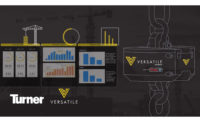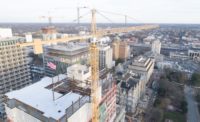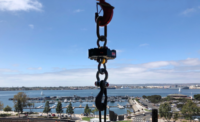When trying to get the absolutely most out of hook time, Hawaiian Dredging Construction Co. often looks to one particular employee. Superintendent Lewie Candler has been managing cranes for a long time, and his personal commitment to tracking crane utilization has him pushing the limits of site productivity.
“I normally take crane pick notes for eight days and then I check if someone messes up,” says Candler. “But I only had one person in management behind me taking these notes back when I started.” Candler’s manual data-collection process has kept projects moving for Hawaiian Dredging when he can make the time to be on site. But the firm recently started using Versatile’s CraneView crane sensor package to track crane utilization on the Central Ala Moana condominium tower project in in Honolulu. With a 43-story tower that will be topping out soon, the project was already under schedule pressure when CraneView was brought on due to initial delays in permitting.
Candler was skeptical at first of the CraneView device, which features a load cell and a camera wirelessly linked to an AI-based, machine-vision algorithm. But he quickly found it confirmed what he had been trying to prove. “It's no surprise to me that it confirms what I’ve got in my notes,” he says. “But for other [superintendents] who haven’t taken these notes, it’s a huge shortcut for them since they can go back and review what was done [with the cranes].”
CraneView is more than just another crane camera. Mounted just below the hook, the system is able to identify and analyze every crane pick, and provide specific lift data as well as aggregate metrics on crane utilization and productivity. Reports and alerts generated by the system keep site personnel informed on how well their cranes are being used, and on possible sources of slowdowns or delays.
“In my opinion, CraneView has validated what Lewie does,” says Derek Kochi, project engineer with Hawaiian Dredging. “It’s making sure his notes align with their notes.”
And what it has confirmed is an unusually high productivity. “We normally hit 92% to 96% crane usage, and we hit 96% often,” says Candler. “I believe on this job we were the only ones that [among CraneView users] has hit 100% crane usage.” Candler says by his calculation every minute of crane time on one of his jobs costs $186, and he drills that figure into his crews whenever a pick seems to take too long. “They’re well educated on what that crane is costing. I don’t let them waste three seconds,” he says.
CraneView has been used on other projects, including a successful pilot effort with Turner Construction earlier this year. But the success of the device on the Central Ala Moana job has convinced Hawaiian Dredging to roll it out to other projects as well. “We’re expanding CraneView to two other sites right now,” says Chris Baze, BIM manager for Hawaiian Dredging. “Like Lewie has said, this is validating the hard and efficient work we are doing on site. And being able to archive and better document best practices as they are occurring is big for us. Lewie can’t be on every site all the time.”
Hawaiian Dredging has signed on to use CraneView on an additional 10 cranes over the next two years, which Baze says will cover all of the cranes the firm expects to deploy in that timeframe.
But the benefits of CraneView for projects go beyond just replicating the diligence of one mindful superintendent. It has also helped Hawaiian Dredging settle debates on crane usage. “On another job, we had a general superintendent arguing we could operate more efficiently with two cranes on the tower rather than just one,” recalls Kochi. “When we finally deployed CraneView on that job, we had the usage metrics to validate that decision.”
While it is useful to have all the crane usage data at hand, Baze notes Hawaiian Dredging is finding new uses for specific performance data. “Our estimators are really interested in how much overtime we are using on this project. They have to budget in and estimate how much overtime we’re going to use, and now they can get validation of how much of that is happening.” he says. “We’re only at the tip of the iceberg of what we can do with this data. We’re finding more value from this data set as we collect it over time.”







